Financial Accounting Report: Financial Statements and Ratio Analysis
VerifiedAdded on 2023/01/12
|31
|3193
|29
Report
AI Summary
This financial accounting report delves into the core principles of financial accounting, beginning with an introduction to the process of recording, summarizing, analyzing, and presenting financial statements. The report covers the recording of business transactions using double-entry bookkeeping, including sales, purchases, receipts, and payments, while adhering to GAAP and IFRS regulations. It also covers the preparation of trial balances, including identifying and rectifying errors. The report then proceeds to the preparation of final accounts for sole traders, partnership firms, and limited corporations, including journal entries, ledgers, the profit and loss account, and the balance sheet. Furthermore, the report includes ratio analysis, such as return on capital employed, gross profit margin, and net profit margin to evaluate the financial performance of a company. The report also provides a statement of profit or loss and a statement of financial position in accordance with International Accounting Standards (IAS). The report concludes with the calculation and analysis of key financial ratios to assess the financial health of a company.
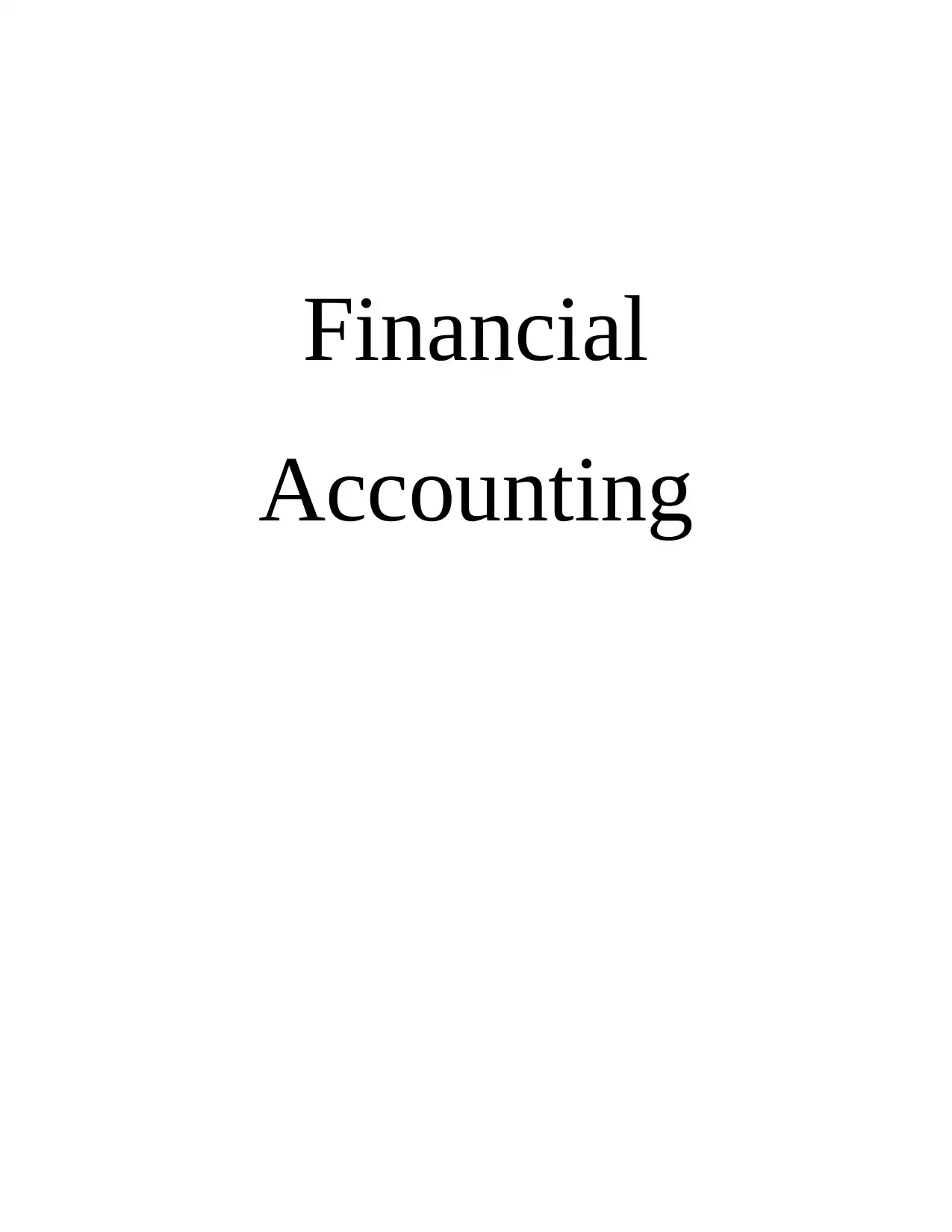
Financial
Accounting
Accounting
Paraphrase This Document
Need a fresh take? Get an instant paraphrase of this document with our AI Paraphraser
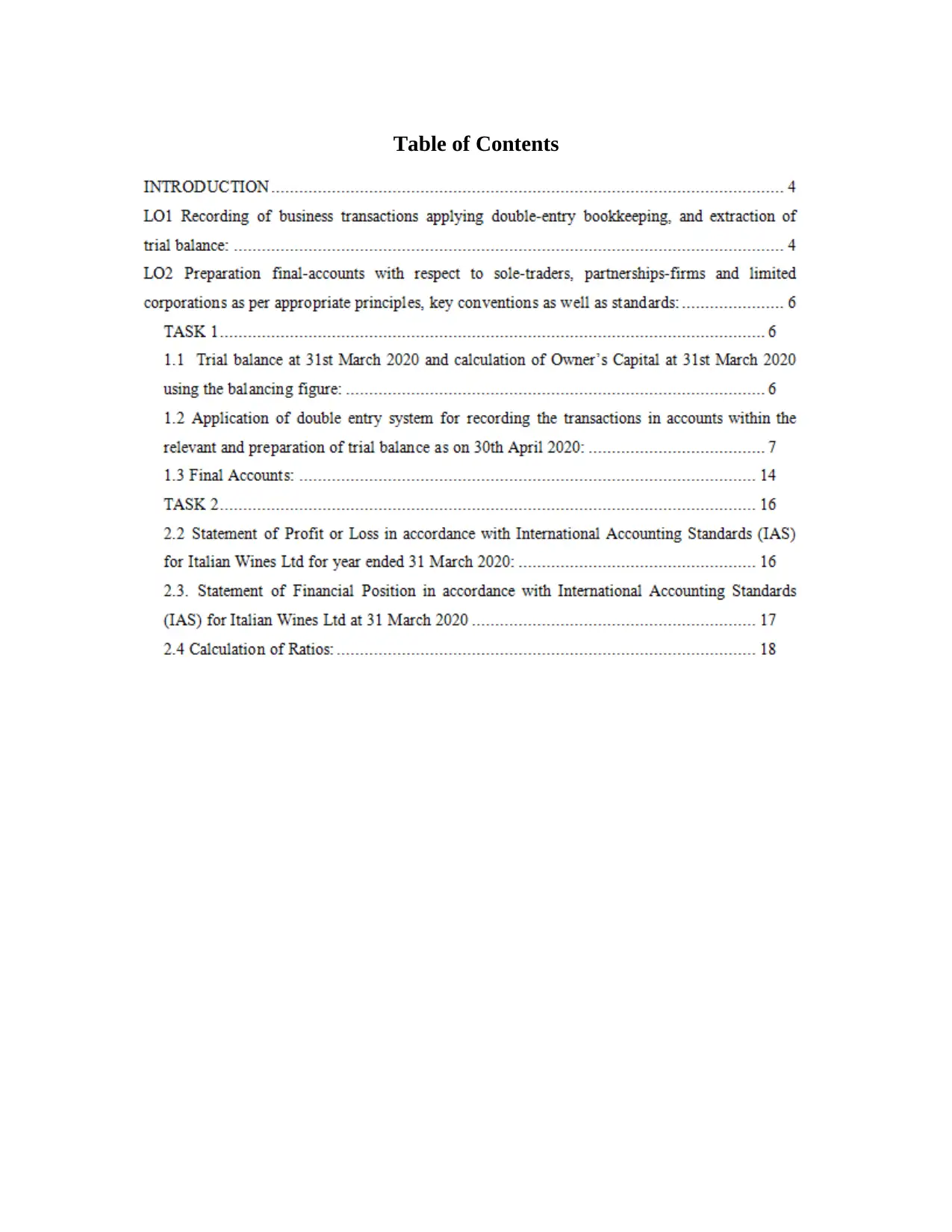
Table of Contents
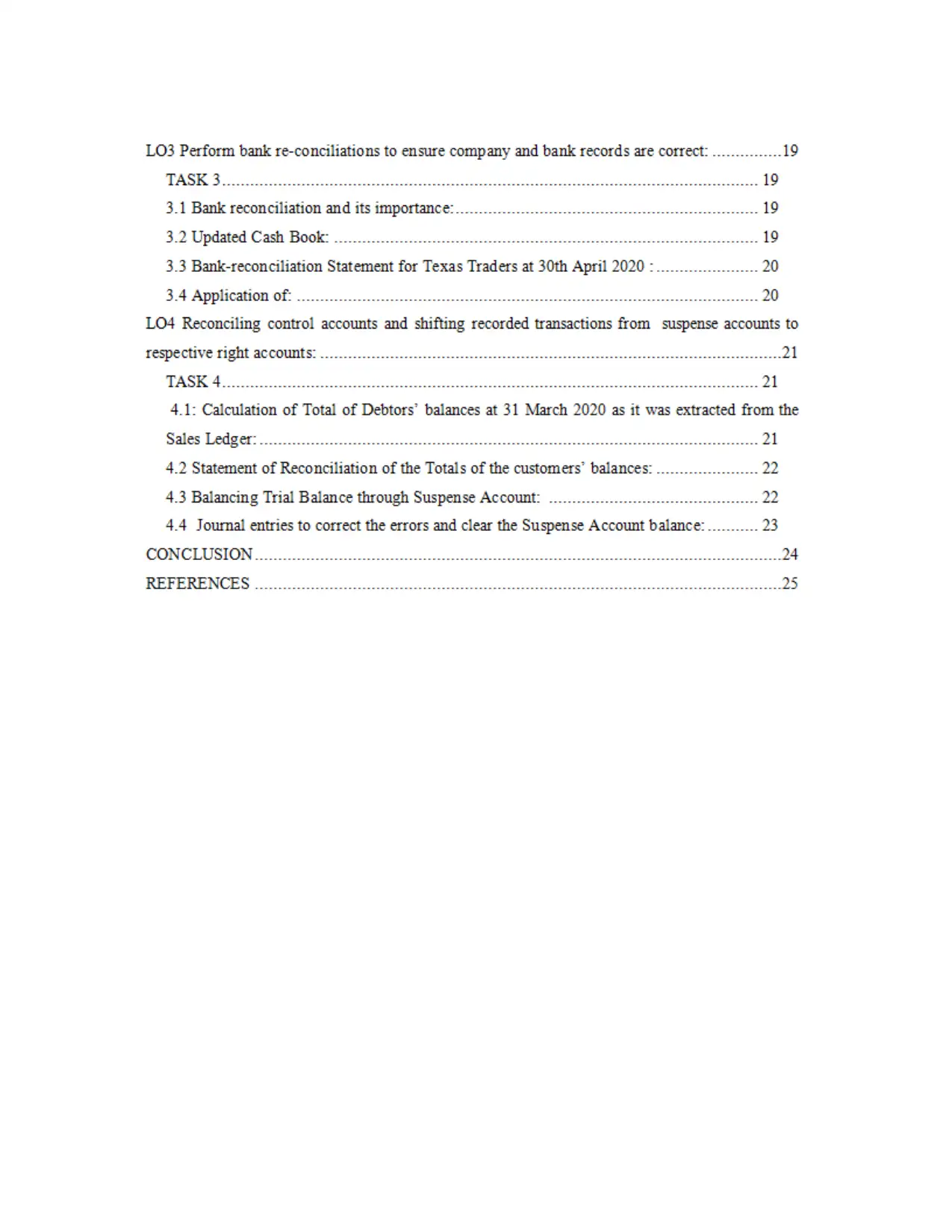
⊘ This is a preview!⊘
Do you want full access?
Subscribe today to unlock all pages.

Trusted by 1+ million students worldwide
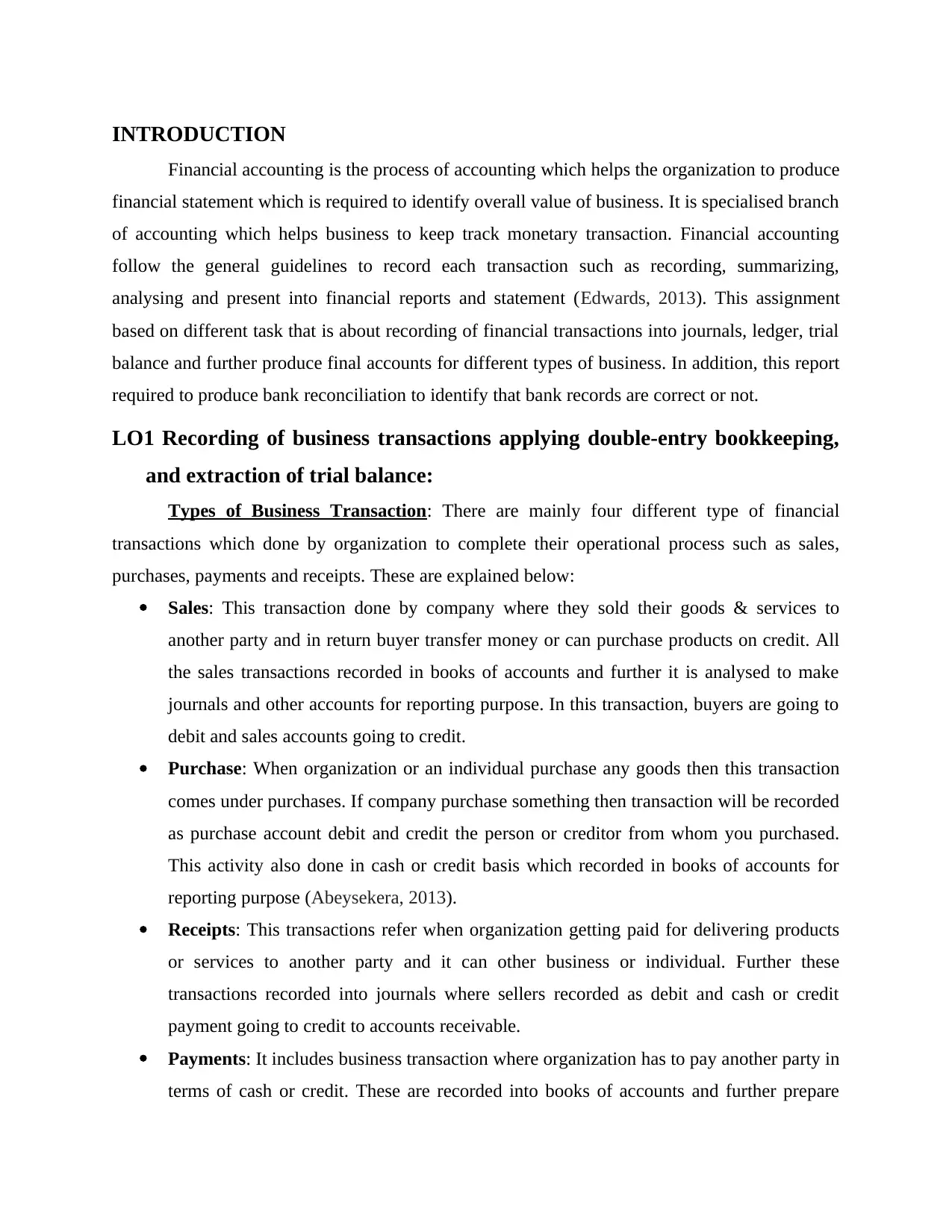
INTRODUCTION
Financial accounting is the process of accounting which helps the organization to produce
financial statement which is required to identify overall value of business. It is specialised branch
of accounting which helps business to keep track monetary transaction. Financial accounting
follow the general guidelines to record each transaction such as recording, summarizing,
analysing and present into financial reports and statement (Edwards, 2013). This assignment
based on different task that is about recording of financial transactions into journals, ledger, trial
balance and further produce final accounts for different types of business. In addition, this report
required to produce bank reconciliation to identify that bank records are correct or not.
LO1 Recording of business transactions applying double-entry bookkeeping,
and extraction of trial balance:
Types of Business Transaction: There are mainly four different type of financial
transactions which done by organization to complete their operational process such as sales,
purchases, payments and receipts. These are explained below:
Sales: This transaction done by company where they sold their goods & services to
another party and in return buyer transfer money or can purchase products on credit. All
the sales transactions recorded in books of accounts and further it is analysed to make
journals and other accounts for reporting purpose. In this transaction, buyers are going to
debit and sales accounts going to credit.
Purchase: When organization or an individual purchase any goods then this transaction
comes under purchases. If company purchase something then transaction will be recorded
as purchase account debit and credit the person or creditor from whom you purchased.
This activity also done in cash or credit basis which recorded in books of accounts for
reporting purpose (Abeysekera, 2013).
Receipts: This transactions refer when organization getting paid for delivering products
or services to another party and it can other business or individual. Further these
transactions recorded into journals where sellers recorded as debit and cash or credit
payment going to credit to accounts receivable.
Payments: It includes business transaction where organization has to pay another party in
terms of cash or credit. These are recorded into books of accounts and further prepare
Financial accounting is the process of accounting which helps the organization to produce
financial statement which is required to identify overall value of business. It is specialised branch
of accounting which helps business to keep track monetary transaction. Financial accounting
follow the general guidelines to record each transaction such as recording, summarizing,
analysing and present into financial reports and statement (Edwards, 2013). This assignment
based on different task that is about recording of financial transactions into journals, ledger, trial
balance and further produce final accounts for different types of business. In addition, this report
required to produce bank reconciliation to identify that bank records are correct or not.
LO1 Recording of business transactions applying double-entry bookkeeping,
and extraction of trial balance:
Types of Business Transaction: There are mainly four different type of financial
transactions which done by organization to complete their operational process such as sales,
purchases, payments and receipts. These are explained below:
Sales: This transaction done by company where they sold their goods & services to
another party and in return buyer transfer money or can purchase products on credit. All
the sales transactions recorded in books of accounts and further it is analysed to make
journals and other accounts for reporting purpose. In this transaction, buyers are going to
debit and sales accounts going to credit.
Purchase: When organization or an individual purchase any goods then this transaction
comes under purchases. If company purchase something then transaction will be recorded
as purchase account debit and credit the person or creditor from whom you purchased.
This activity also done in cash or credit basis which recorded in books of accounts for
reporting purpose (Abeysekera, 2013).
Receipts: This transactions refer when organization getting paid for delivering products
or services to another party and it can other business or individual. Further these
transactions recorded into journals where sellers recorded as debit and cash or credit
payment going to credit to accounts receivable.
Payments: It includes business transaction where organization has to pay another party in
terms of cash or credit. These are recorded into books of accounts and further prepare
Paraphrase This Document
Need a fresh take? Get an instant paraphrase of this document with our AI Paraphraser
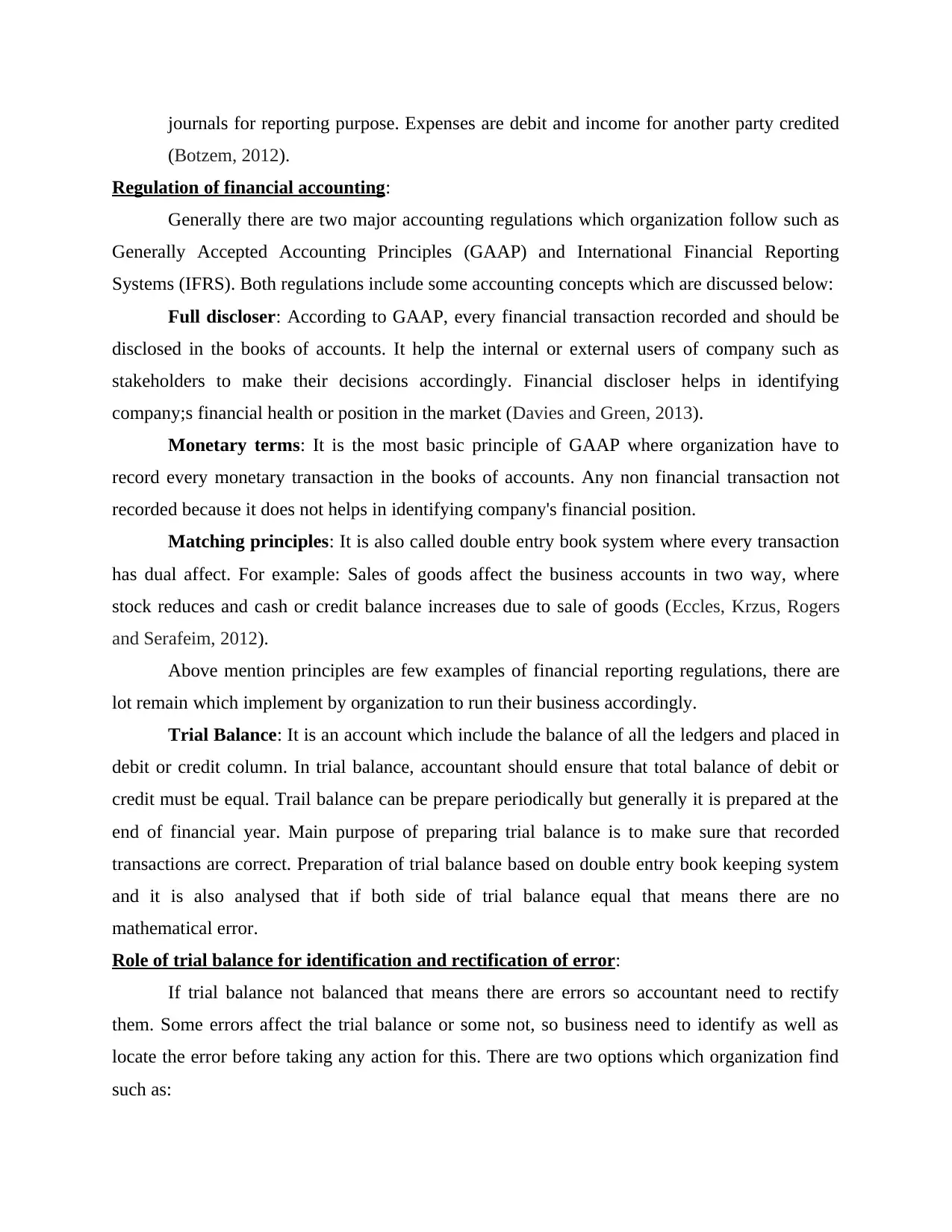
journals for reporting purpose. Expenses are debit and income for another party credited
(Botzem, 2012).
Regulation of financial accounting:
Generally there are two major accounting regulations which organization follow such as
Generally Accepted Accounting Principles (GAAP) and International Financial Reporting
Systems (IFRS). Both regulations include some accounting concepts which are discussed below:
Full discloser: According to GAAP, every financial transaction recorded and should be
disclosed in the books of accounts. It help the internal or external users of company such as
stakeholders to make their decisions accordingly. Financial discloser helps in identifying
company;s financial health or position in the market (Davies and Green, 2013).
Monetary terms: It is the most basic principle of GAAP where organization have to
record every monetary transaction in the books of accounts. Any non financial transaction not
recorded because it does not helps in identifying company's financial position.
Matching principles: It is also called double entry book system where every transaction
has dual affect. For example: Sales of goods affect the business accounts in two way, where
stock reduces and cash or credit balance increases due to sale of goods (Eccles, Krzus, Rogers
and Serafeim, 2012).
Above mention principles are few examples of financial reporting regulations, there are
lot remain which implement by organization to run their business accordingly.
Trial Balance: It is an account which include the balance of all the ledgers and placed in
debit or credit column. In trial balance, accountant should ensure that total balance of debit or
credit must be equal. Trail balance can be prepare periodically but generally it is prepared at the
end of financial year. Main purpose of preparing trial balance is to make sure that recorded
transactions are correct. Preparation of trial balance based on double entry book keeping system
and it is also analysed that if both side of trial balance equal that means there are no
mathematical error.
Role of trial balance for identification and rectification of error:
If trial balance not balanced that means there are errors so accountant need to rectify
them. Some errors affect the trial balance or some not, so business need to identify as well as
locate the error before taking any action for this. There are two options which organization find
such as:
(Botzem, 2012).
Regulation of financial accounting:
Generally there are two major accounting regulations which organization follow such as
Generally Accepted Accounting Principles (GAAP) and International Financial Reporting
Systems (IFRS). Both regulations include some accounting concepts which are discussed below:
Full discloser: According to GAAP, every financial transaction recorded and should be
disclosed in the books of accounts. It help the internal or external users of company such as
stakeholders to make their decisions accordingly. Financial discloser helps in identifying
company;s financial health or position in the market (Davies and Green, 2013).
Monetary terms: It is the most basic principle of GAAP where organization have to
record every monetary transaction in the books of accounts. Any non financial transaction not
recorded because it does not helps in identifying company's financial position.
Matching principles: It is also called double entry book system where every transaction
has dual affect. For example: Sales of goods affect the business accounts in two way, where
stock reduces and cash or credit balance increases due to sale of goods (Eccles, Krzus, Rogers
and Serafeim, 2012).
Above mention principles are few examples of financial reporting regulations, there are
lot remain which implement by organization to run their business accordingly.
Trial Balance: It is an account which include the balance of all the ledgers and placed in
debit or credit column. In trial balance, accountant should ensure that total balance of debit or
credit must be equal. Trail balance can be prepare periodically but generally it is prepared at the
end of financial year. Main purpose of preparing trial balance is to make sure that recorded
transactions are correct. Preparation of trial balance based on double entry book keeping system
and it is also analysed that if both side of trial balance equal that means there are no
mathematical error.
Role of trial balance for identification and rectification of error:
If trial balance not balanced that means there are errors so accountant need to rectify
them. Some errors affect the trial balance or some not, so business need to identify as well as
locate the error before taking any action for this. There are two options which organization find
such as:
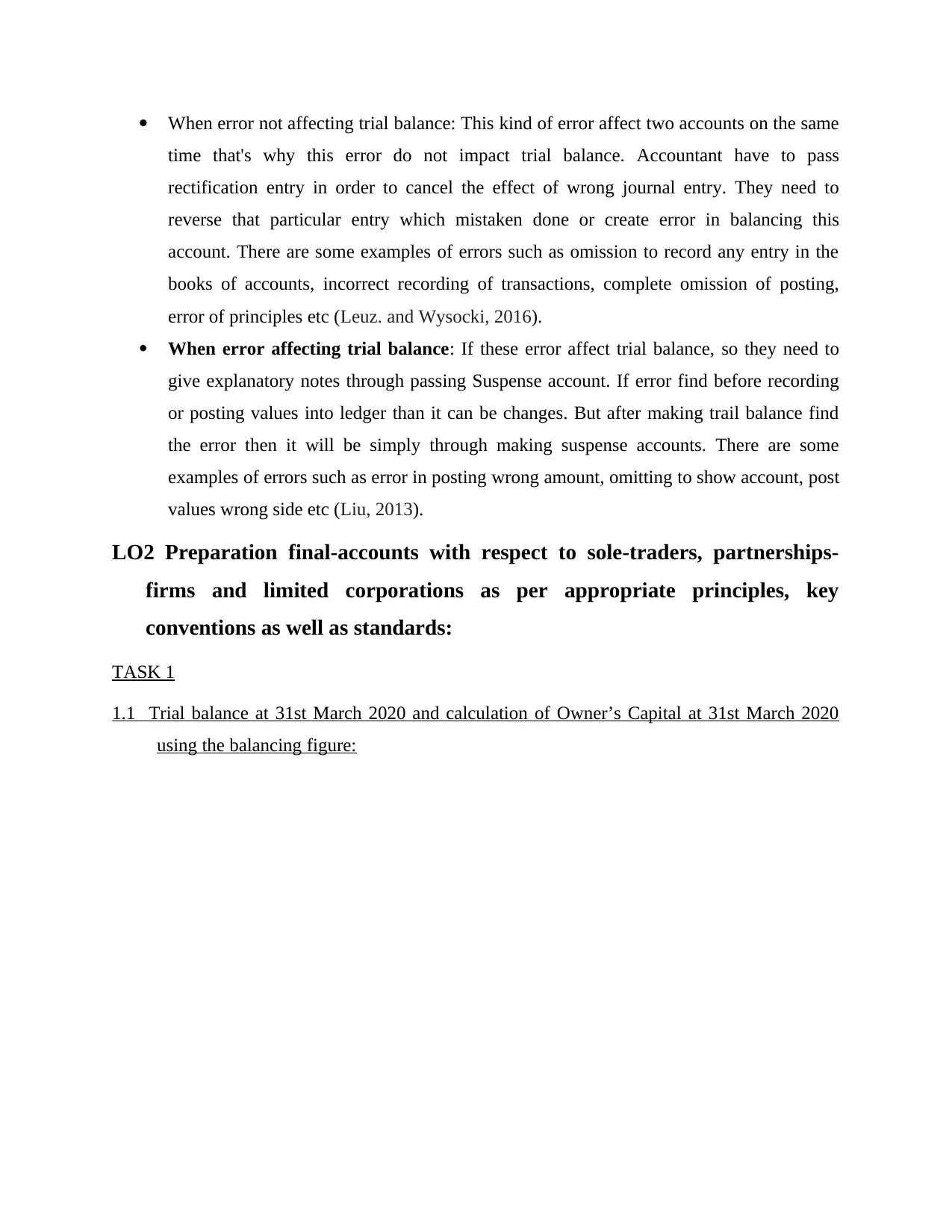
When error not affecting trial balance: This kind of error affect two accounts on the same
time that's why this error do not impact trial balance. Accountant have to pass
rectification entry in order to cancel the effect of wrong journal entry. They need to
reverse that particular entry which mistaken done or create error in balancing this
account. There are some examples of errors such as omission to record any entry in the
books of accounts, incorrect recording of transactions, complete omission of posting,
error of principles etc (Leuz. and Wysocki, 2016).
When error affecting trial balance: If these error affect trial balance, so they need to
give explanatory notes through passing Suspense account. If error find before recording
or posting values into ledger than it can be changes. But after making trail balance find
the error then it will be simply through making suspense accounts. There are some
examples of errors such as error in posting wrong amount, omitting to show account, post
values wrong side etc (Liu, 2013).
LO2 Preparation final-accounts with respect to sole-traders, partnerships-
firms and limited corporations as per appropriate principles, key
conventions as well as standards:
TASK 1
1.1 Trial balance at 31st March 2020 and calculation of Owner’s Capital at 31st March 2020
using the balancing figure:
time that's why this error do not impact trial balance. Accountant have to pass
rectification entry in order to cancel the effect of wrong journal entry. They need to
reverse that particular entry which mistaken done or create error in balancing this
account. There are some examples of errors such as omission to record any entry in the
books of accounts, incorrect recording of transactions, complete omission of posting,
error of principles etc (Leuz. and Wysocki, 2016).
When error affecting trial balance: If these error affect trial balance, so they need to
give explanatory notes through passing Suspense account. If error find before recording
or posting values into ledger than it can be changes. But after making trail balance find
the error then it will be simply through making suspense accounts. There are some
examples of errors such as error in posting wrong amount, omitting to show account, post
values wrong side etc (Liu, 2013).
LO2 Preparation final-accounts with respect to sole-traders, partnerships-
firms and limited corporations as per appropriate principles, key
conventions as well as standards:
TASK 1
1.1 Trial balance at 31st March 2020 and calculation of Owner’s Capital at 31st March 2020
using the balancing figure:
⊘ This is a preview!⊘
Do you want full access?
Subscribe today to unlock all pages.

Trusted by 1+ million students worldwide
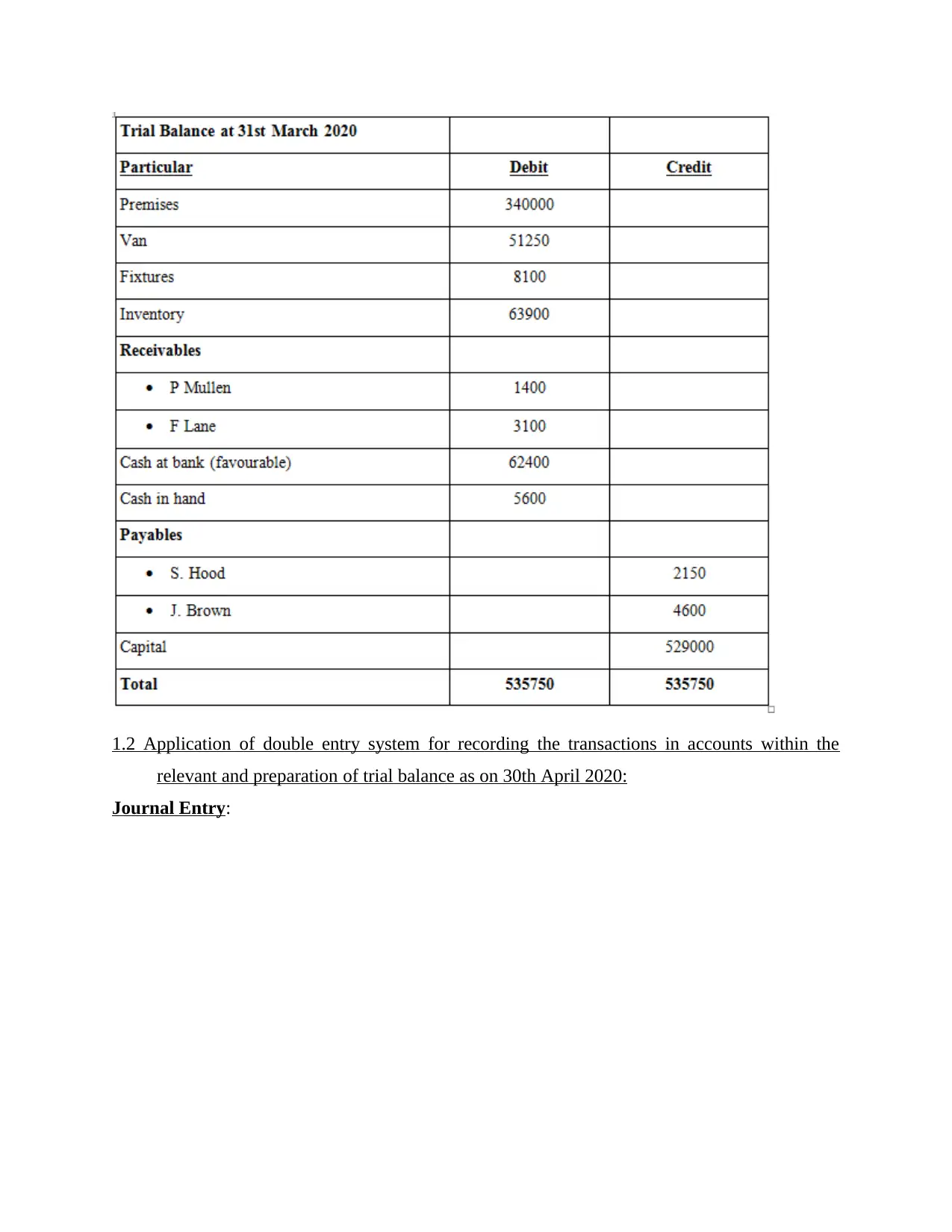
1.2 Application of double entry system for recording the transactions in accounts within the
relevant and preparation of trial balance as on 30th April 2020:
Journal Entry:
relevant and preparation of trial balance as on 30th April 2020:
Journal Entry:
Paraphrase This Document
Need a fresh take? Get an instant paraphrase of this document with our AI Paraphraser
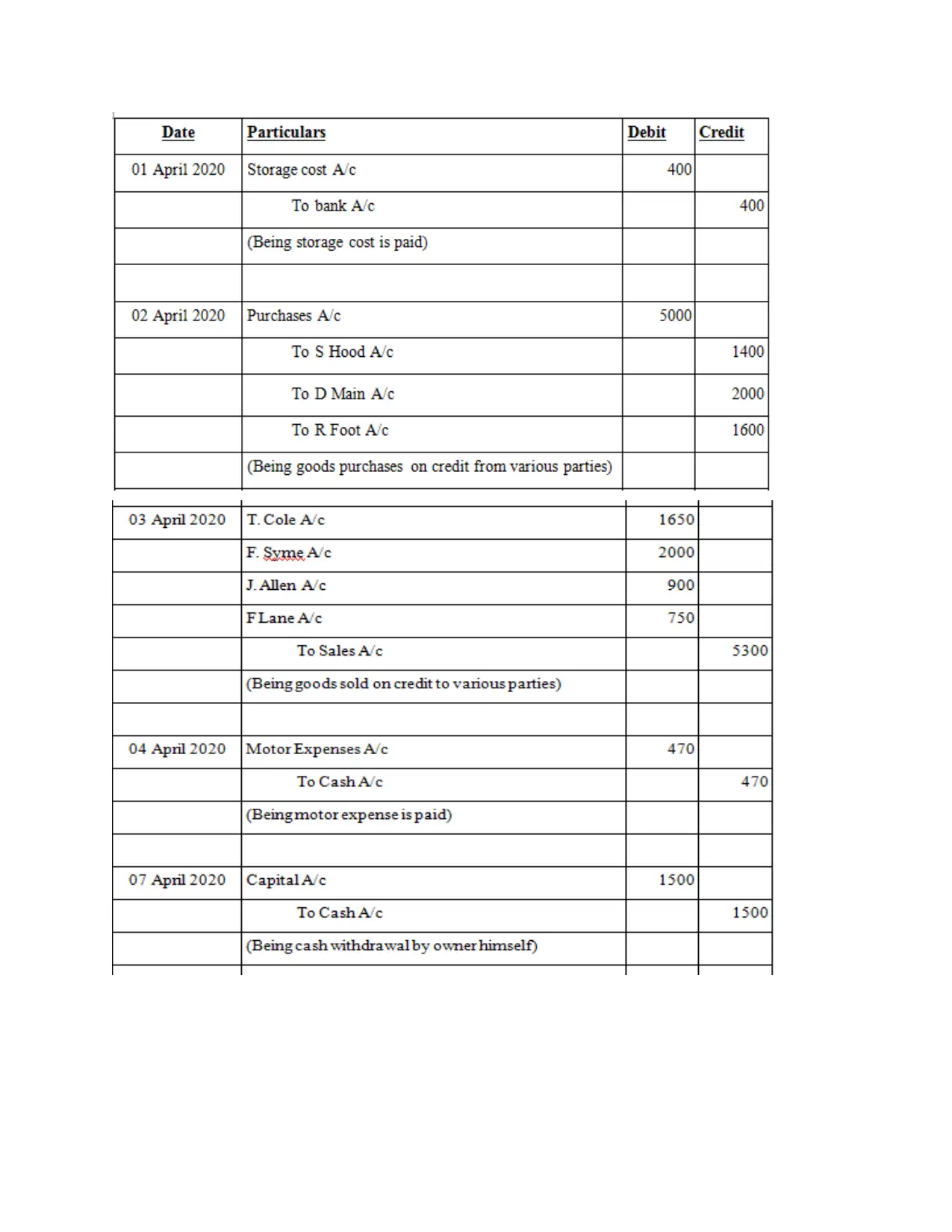
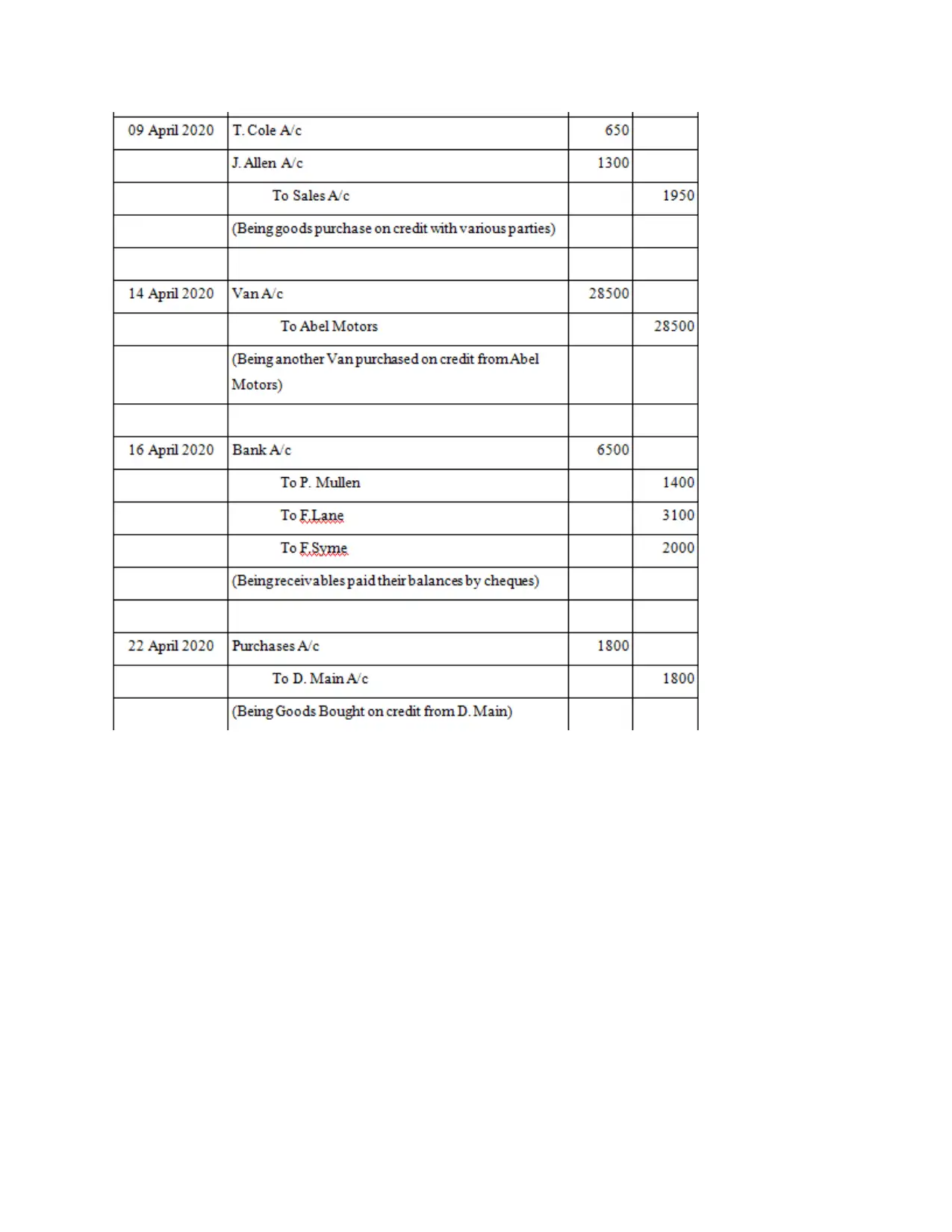
⊘ This is a preview!⊘
Do you want full access?
Subscribe today to unlock all pages.

Trusted by 1+ million students worldwide
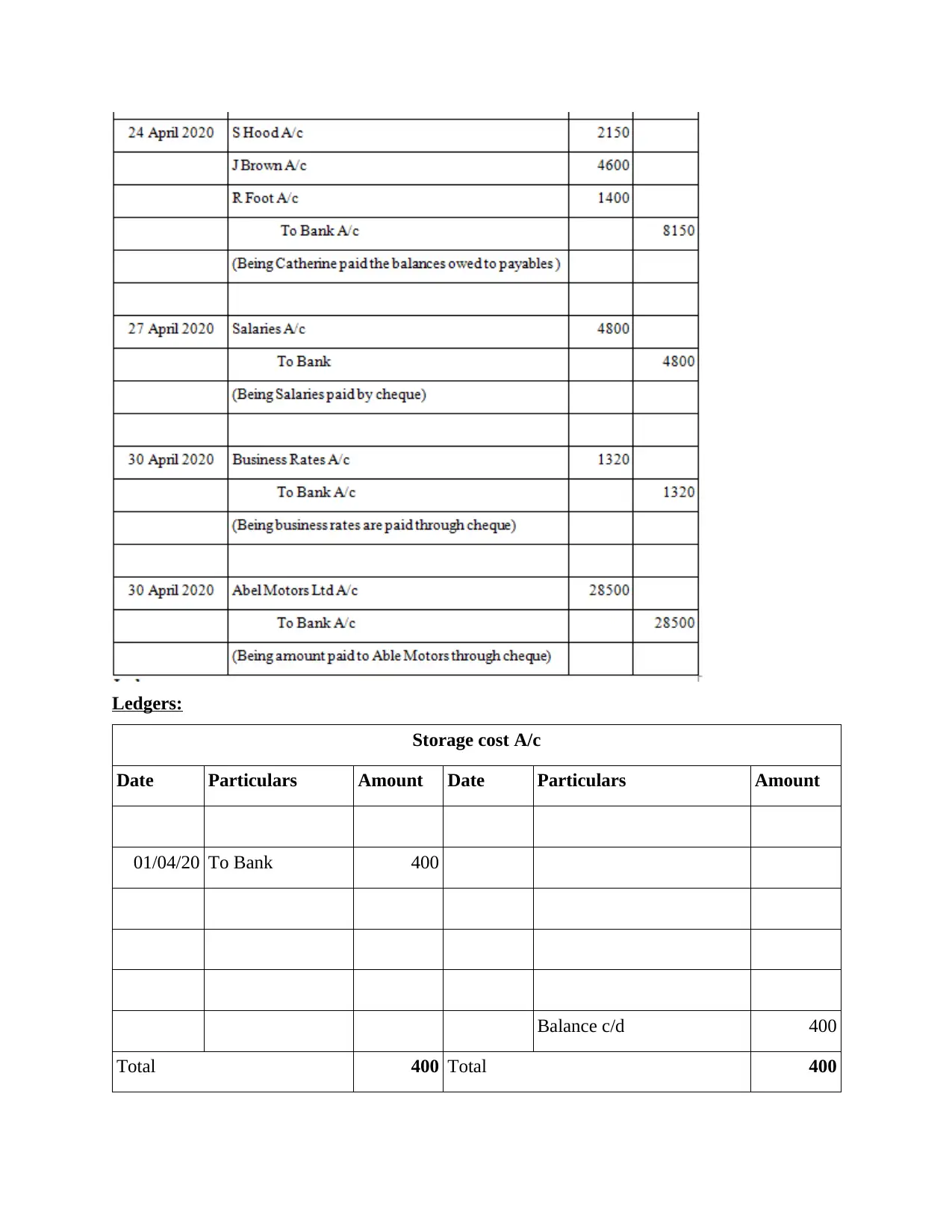
Ledgers:
Storage cost A/c
Date Particulars Amount Date Particulars Amount
01/04/20 To Bank 400
Balance c/d 400
Total 400 Total 400
Storage cost A/c
Date Particulars Amount Date Particulars Amount
01/04/20 To Bank 400
Balance c/d 400
Total 400 Total 400
Paraphrase This Document
Need a fresh take? Get an instant paraphrase of this document with our AI Paraphraser
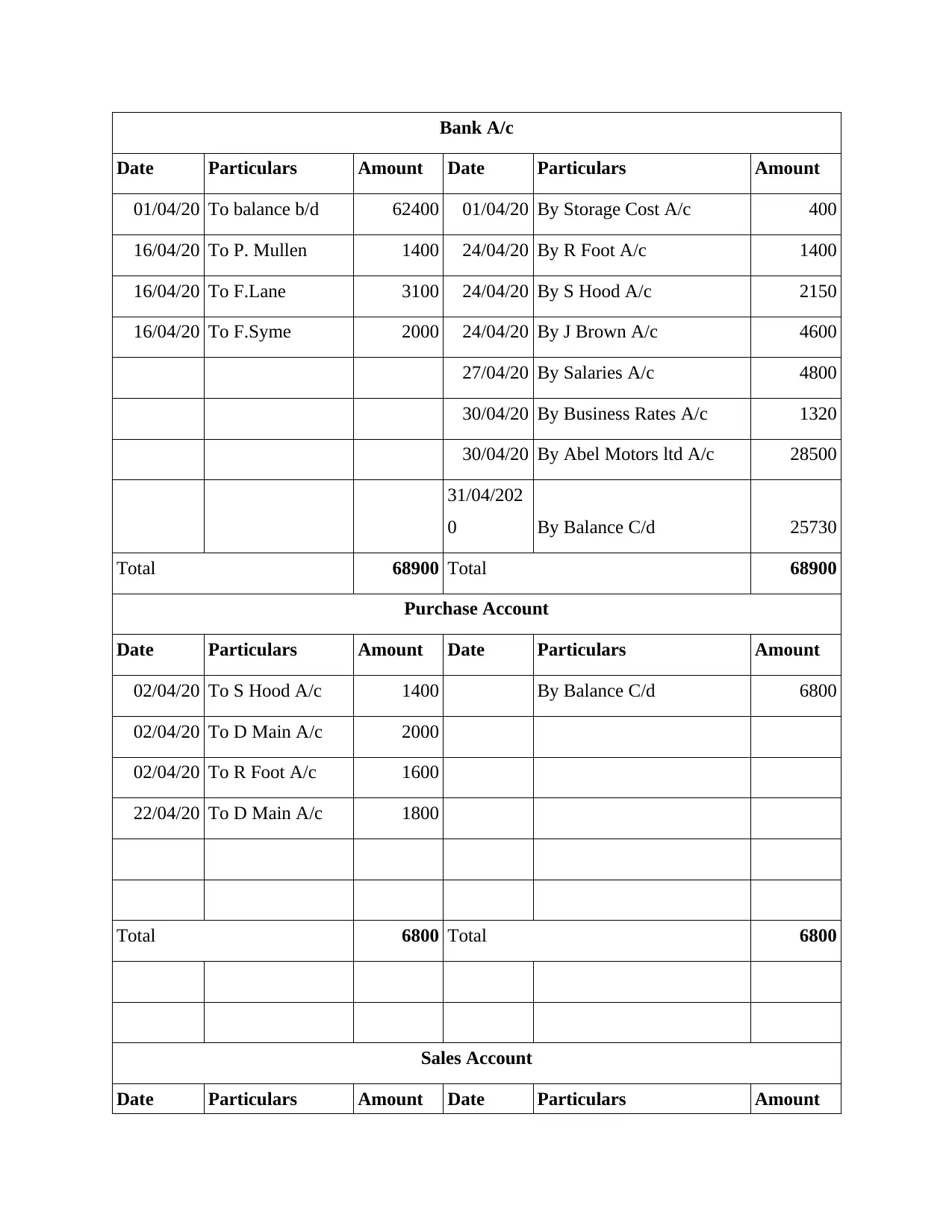
Bank A/c
Date Particulars Amount Date Particulars Amount
01/04/20 To balance b/d 62400 01/04/20 By Storage Cost A/c 400
16/04/20 To P. Mullen 1400 24/04/20 By R Foot A/c 1400
16/04/20 To F.Lane 3100 24/04/20 By S Hood A/c 2150
16/04/20 To F.Syme 2000 24/04/20 By J Brown A/c 4600
27/04/20 By Salaries A/c 4800
30/04/20 By Business Rates A/c 1320
30/04/20 By Abel Motors ltd A/c 28500
31/04/202
0 By Balance C/d 25730
Total 68900 Total 68900
Purchase Account
Date Particulars Amount Date Particulars Amount
02/04/20 To S Hood A/c 1400 By Balance C/d 6800
02/04/20 To D Main A/c 2000
02/04/20 To R Foot A/c 1600
22/04/20 To D Main A/c 1800
Total 6800 Total 6800
Sales Account
Date Particulars Amount Date Particulars Amount
Date Particulars Amount Date Particulars Amount
01/04/20 To balance b/d 62400 01/04/20 By Storage Cost A/c 400
16/04/20 To P. Mullen 1400 24/04/20 By R Foot A/c 1400
16/04/20 To F.Lane 3100 24/04/20 By S Hood A/c 2150
16/04/20 To F.Syme 2000 24/04/20 By J Brown A/c 4600
27/04/20 By Salaries A/c 4800
30/04/20 By Business Rates A/c 1320
30/04/20 By Abel Motors ltd A/c 28500
31/04/202
0 By Balance C/d 25730
Total 68900 Total 68900
Purchase Account
Date Particulars Amount Date Particulars Amount
02/04/20 To S Hood A/c 1400 By Balance C/d 6800
02/04/20 To D Main A/c 2000
02/04/20 To R Foot A/c 1600
22/04/20 To D Main A/c 1800
Total 6800 Total 6800
Sales Account
Date Particulars Amount Date Particulars Amount
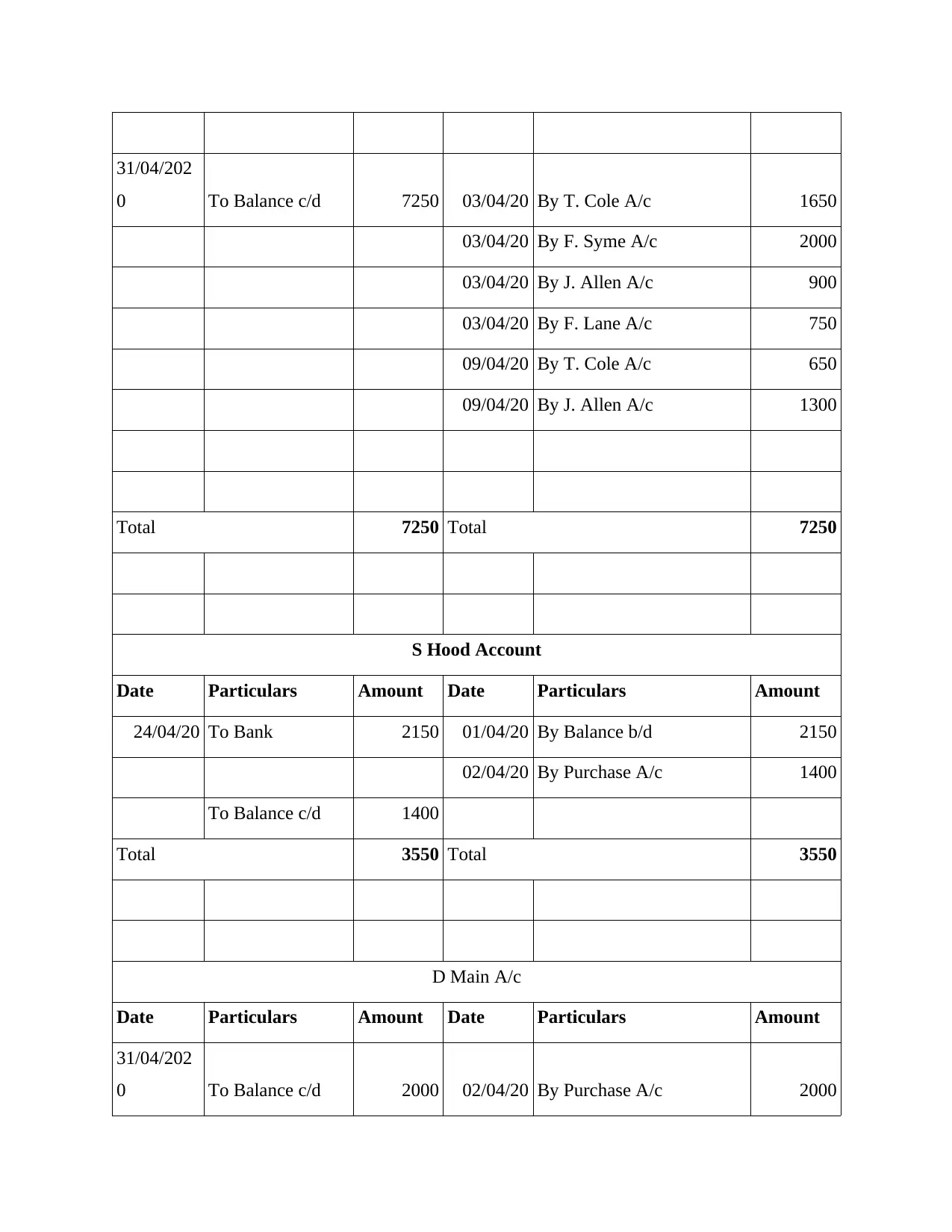
31/04/202
0 To Balance c/d 7250 03/04/20 By T. Cole A/c 1650
03/04/20 By F. Syme A/c 2000
03/04/20 By J. Allen A/c 900
03/04/20 By F. Lane A/c 750
09/04/20 By T. Cole A/c 650
09/04/20 By J. Allen A/c 1300
Total 7250 Total 7250
S Hood Account
Date Particulars Amount Date Particulars Amount
24/04/20 To Bank 2150 01/04/20 By Balance b/d 2150
02/04/20 By Purchase A/c 1400
To Balance c/d 1400
Total 3550 Total 3550
D Main A/c
Date Particulars Amount Date Particulars Amount
31/04/202
0 To Balance c/d 2000 02/04/20 By Purchase A/c 2000
0 To Balance c/d 7250 03/04/20 By T. Cole A/c 1650
03/04/20 By F. Syme A/c 2000
03/04/20 By J. Allen A/c 900
03/04/20 By F. Lane A/c 750
09/04/20 By T. Cole A/c 650
09/04/20 By J. Allen A/c 1300
Total 7250 Total 7250
S Hood Account
Date Particulars Amount Date Particulars Amount
24/04/20 To Bank 2150 01/04/20 By Balance b/d 2150
02/04/20 By Purchase A/c 1400
To Balance c/d 1400
Total 3550 Total 3550
D Main A/c
Date Particulars Amount Date Particulars Amount
31/04/202
0 To Balance c/d 2000 02/04/20 By Purchase A/c 2000
⊘ This is a preview!⊘
Do you want full access?
Subscribe today to unlock all pages.

Trusted by 1+ million students worldwide
1 out of 31
Related Documents
Your All-in-One AI-Powered Toolkit for Academic Success.
+13062052269
info@desklib.com
Available 24*7 on WhatsApp / Email
![[object Object]](/_next/static/media/star-bottom.7253800d.svg)
Unlock your academic potential
Copyright © 2020–2025 A2Z Services. All Rights Reserved. Developed and managed by ZUCOL.





